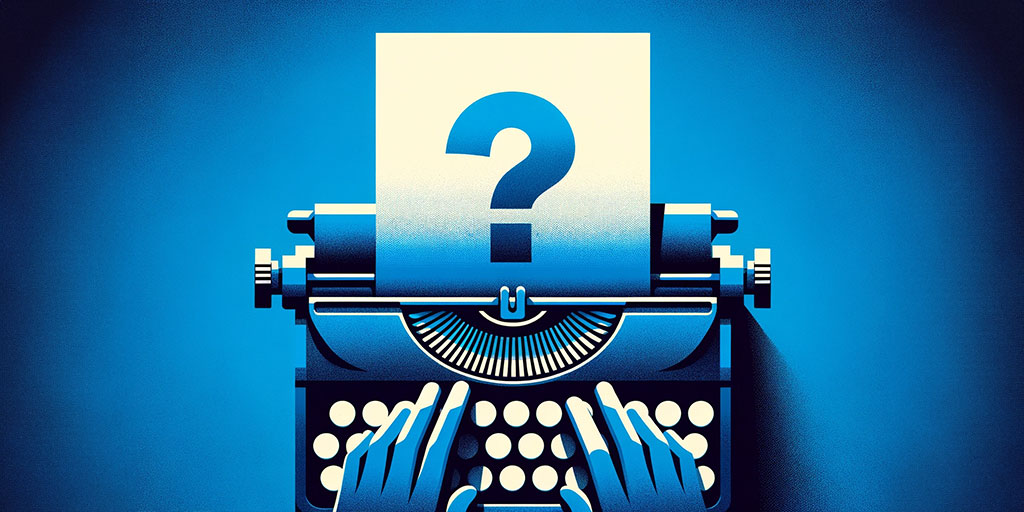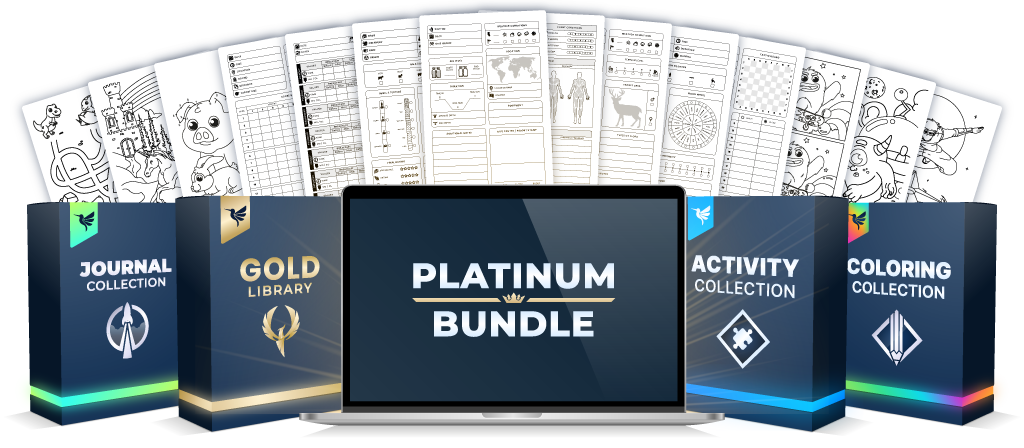Stories have been an integral part of human culture for centuries. However, creating a compelling story is not an easy feat, as it requires careful planning and execution to keep readers engaged. Without a doubt, one of the most critical aspects in storytelling is story structure, which provides the framework for the narrative to unfold.
In this guide, we will explore 15 narrative structures that can help you craft powerful and impactful plots. We will delve into each approach and offer tips on how to apply them effectively in order to create memorable and engaging stories that resonate with your audience.
What is Narrative Structure?
Narrative structure refers to how a story is structured and presented to its intended audience. It involves the way that the plot components are arranged, including elements like exposition, rising action, climax, falling action, and resolution.
Authors have a variety of story structures to choose from, ranging from traditional linear and chronological ones to more experimental and non-linear frameworks. Effective construction can captivate and engage the audience, while a poorly structured story can result in confusion and detachment.
Writing a full-length novel is a daunting task, especially for new authors. It is much easier to know what story you want to tell than it is to construct it into something that flows coherently. That is why story structure is important, and it is a skill that can actually be learned.
A good story structure helps you to create a narrative that flows smoothly, to develop characters and themes within the story, to create suspense and intrigue, and to create a satisfying resolution. As such, it makes it easier for your readers to remain interested and to understand and follow along with the plot.
Craft of Writing Quiz (Easy)

Story Structure Elements
Story structure elements are the building blocks of a narrative. They help to produce a coherent story. Below are the most common elements you will use when crafting fiction.
Opener/Status Quo
The status quo establishes the world and characters in their normal state of being. In linear and chronological storytelling, it appears at the beginning of the novel, but it can appear elsewhere. It includes a lot of introductory information about the setting and characters.
Inciting Incident
The inciting incident is the event that disrupts the status quo and sets the story in motion. It is the event that triggers the protagonist’s journey and sets them on a new path.
Rising Action/Crisis
The rising action is the series of events that build tension and lead up to the story’s climax. It is the phase where the protagonist faces obstacles and begins to develop and change as a character.
Climax
The climax is the point of maximum tension in the story, where the protagonist faces their greatest challenge or conflict.
Falling Action
The falling action is the aftermath of the climax, where the story begins to wind down and loose ends are tied up.
End/Resolution
The resolution is the final outcome of the story, where the conflict is resolved and the protagonist’s journey comes to an end.
15 Powerful Story Structures
In this section, we will explore 15 powerful plot structures that writers can use to craft their stories. From the classic three-act framework to the more experimental kishōtenketsu style, this is where you will learn how to construct good narratives.
- Three-Act Structure
- Hero’s Journey
- Dan Harmon’s Story Circle
- Tragic Plot Embryo
- Freytag’s Pyramid
- Five-Act Structure
- Fichtean Curve
- Save the Cat Beat Sheet
- A Disturbance and Two Doorways
- Seven-Point Structure
- Snowflake Method
- Kishōtenketsu Structure
- Red Herring Structure
- Story Spine
- In Medias Res
1. Three-Act Structure
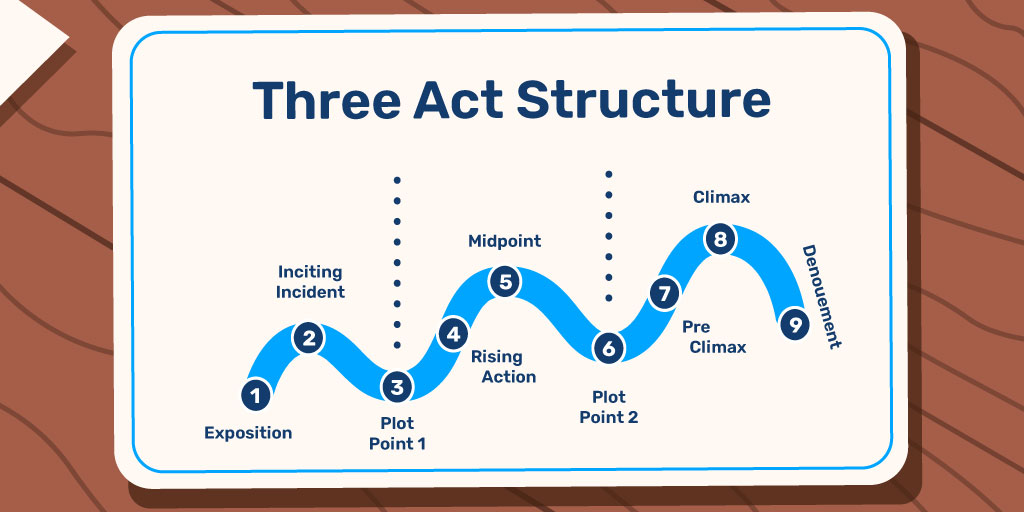
Most of the story structures on this list use some version of the three-act structure, since it basically involves a beginning, a middle and an end. It is the simplest way to tell a story.
It proceeds through the following steps:
- The setup: The author introduces the main characters, the setting, the story’s premise, the stakes, and the main conflict.
- Confrontation: The main character faces increasing obstacles that prevent them from achieving their goals. The obstacles are too big and they fail at their mission. Subplots and secondary characters are used to add complexity to the story.
- Resolution: The climax takes place where they face their opponents one last time. This is followed by a brief period of denouement where the consequences of the climax occur.
Absolutely any genre fits well with the three-act structure, including thrillers, romance, drama, comedy, action, and adventure.
Example of the Three-Act Structure
The Hunger Games, by Suzanne Collins, illustrates this well. In a dystopian society, Katniss faces difficulties in supporting her family and ultimately volunteers for her younger sister in the Hunger Games (1).
Throughout the games, she experiences intense challenges and eventually reaches a point where she is forced to fight Peeta, which means she cannot achieve a goal that she can bear (2).
In a defiant move, Katniss and Peeta threaten to consume poisonous berries in lieu of fighting each other, ultimately leading to both being declared winners. Following their victory tour, Katniss emerges as a leader in the rebellion against the Capitol (3).
2. Hero’s Journey
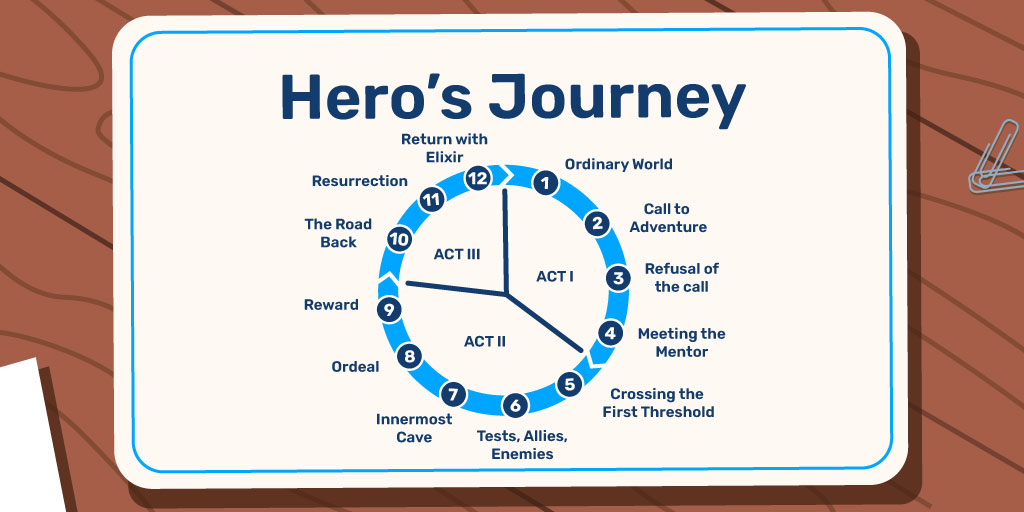
The Hero’s Journey is a story structure that typically begins with the disruption of the protagonist’s ordinary life by a call to adventure, which they eventually accept. Throughout their quest, the hero must face and overcome challenges and adversaries, ultimately emerging victorious. The journey often culminates in the hero’s return home, transformed by their experiences.
The less streamlined, but more helpful, version has 12 steps:
- The ordinary world: The author describes the hero’s normal life.
- Call to adventure: Someone calls the hero to embark on a journey or quest.
- Refusal of the call: The hero doesn’t want to leave a comfortable life behind and initially refuses the call.
- Meeting with the mentor: A mentor or guide enters the story and gives the hero guidance and wisdom for the journey.
- Crossing the threshold: The journey begins, with the hero leaving normal life behind and crossing a threshold into a new world.
- Tests, allies, and enemies: The hero faces a series of challenges and obstacles, often with the help of allies and the opposition of enemies.
- Approach to the inmost cave: The hero approaches the heart of their journey or quest, facing their greatest challenges and obstacles.
- The ordeal: A major challenge or crisis presents itself, often in the form of a life-or-death situation that tests the hero’s strength and character.
- The reward: The hero emerges from the ordeal victorious, having gained a reward or treasure that will help them complete their journey.
- The road back: The process of the hero’s return to normal life begins, often including new conflicts along the way.
- The resurrection: The hero faces a final challenge or crisis, often involving a confrontation with the story’s primary antagonist.
- The return with the elixir: Having completed the journey transformed with new knowledge, wisdom, or power, the hero returns to ordinary life.
This structure works well in genres that incorporate adventure, self-discovery, and transformation, such as fantasy, science fiction, superhero, coming-of-age, or even dramas with personal obstacles.
Example of the Hero’s Journey
Much of Simba’s story in The Lion King follows this framework. He lives an ordinary life in exile with Timon and Pumbaa (1), until Nala informs him that the Pride Lands have become drought-stricken under Scar’s reign and begs him to return to claim his kingship (2). Scar is his uncle, who previously stole the kingship from him.
Simba first refuses (3), but is then convinced by Rafiki and his dad’s spirit (4).
He crosses the threshold when he leaves his home (5). Throughout this period, there are lots of challenges, like sneaking past the hyenas, though many allies join him in his quest, including Timon, Pumbaa, Rafiki, Zazu, and Nala (6).
He meets his uncle Scar (7) and confronts him in a final battle for the Pride Lands (8). After coming away as the temporary victor (9), he tells Scar to leave the Pride Lands so that he can become king (10).
Scar refuses to leave and attacks Simba. The two fight, Simba throws his uncle off the gorge’s edge where they were fighting, and the hyenas kill him (11). Simba then returns to a new ordinary life as king, having learned the true meaning of leadership and responsibility (12).
3. Dan Harmon’s Story Circle
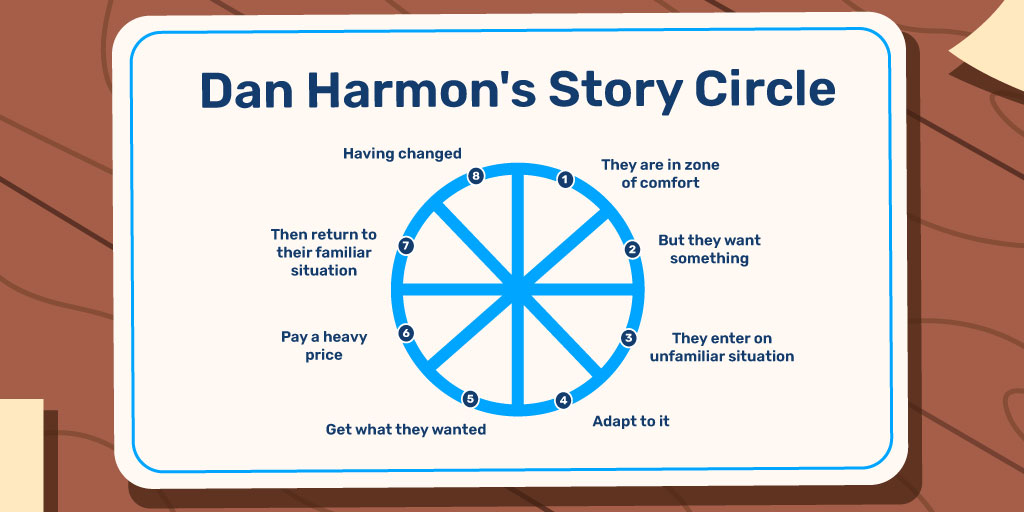
Screenwriter Dan Harmon adapted the Hero’s journey to focus more on character arcs, rather than on action. While the hero’s journey puts external challenges and obstacles in the spotlight, Dan Harmon’s Story Circle focuses on internal transformation and change, even though external challenges are present.
This structure contains eight steps:
- You: A character is in a zone of comfort.
- Need: There is a desire or goal they want to achieve.
- Go: A challenging situation occurs on the way to that goal.
- Search: They adapt to that new situation.
- Find: The characters achieve their goal.
- Take: The price they pay for it is heavy.
- Return: They return to their familiar situation.
- Change: But they have changed, and things are not the same as before.
Stories written according to the hero’s journey structure can often be written using Dan Harmon’s Story Circle too, especially if they involve major stories of transformation and loss.
The hero’s journey is often used for action and adventure stories, while Dan Harmon’s Story Circle can be used for a wider range of narratives. But you don’t have to choose between them. You can map your story onto both structures to ensure that you include both the action (Hero’s Journey) and the character arcs (Dan Harmon’s Story Circle).
Example of Dan Harmon’s Story Circle
Let’s look at The Lion King again, but this time with an emphasis on character, and not on action.
Simba is living a carefree life with his family in the Pride Lands (1), but he wants to be a strong and respected king like his father (2). When his uncle Scar attacks him and manipulates him into leaving the Pride Lands (3), Simba must adapt to a new life in exile with Timon and Pumbaa (4).
Simba learns the truth about Scar’s treachery and cruelty and returns to defeat him (5), but not without paying a heavy price by losing his father (6). Simba returns home as king (7), but he has undergone a transformation and has a newfound respect for his father’s legacy of responsibility and leadership (8).
4. Tragic Plot Embryo

Created by Rachael Stephen, this is an adaptation of Dan Harmon’s story circle in which the character doesn’t learn enough to achieve their desire or goal. In other words, they don’t return to their familiar situation and they don’t transform into something better.
Accordingly, it has only the first six steps:
- You: The character is in a comfortable place, but has a serious flaw that will prevent them from learning or transforming.
- Anticipation: There is a desire or goal they want to achieve, moral or immoral.
- Dream: During the search for the goal, a challenging situation occurs and characters are opposed by hostile forces.
- Frustration: They adapt to that new situation and continue to fight those opposing forces.
- Nightmare: The characters learn that they can achieve their goal, but at an intolerable price.
- Destruction: The extremely high price is paid and they never get to return to their comfortable place.
This structure works very well when your story involves a deeply flawed character or an immoral goal. It is often used in tragedies, dramas, and other serious stories that focus on the downfall of the protagonist. It doesn’t usually include a happy ending or a resolution of the conflict.
Example of the Tragic Plot Embryo
Instead of illustrating this type of narrative structure with Macbeth or Hamlet, by William Shakespeare, which are both good examples, we will look into how The Shining by Stephen King also fits well with this structure.
Jack Torrance is an alcoholic, unemployed, struggling writer. His relationship with his wife, his abstinence from alcohol, and his anger management are difficult, but currently going relatively well (1).
He is in desperate need of a job and money, and takes a job as the off-season caretaker of the Overlook Hotel, an arrangement that might allow him to write (2). As they settle in, Jack and his son Danny have disturbing visions and premonitions, including encounters with the ghosts of the hotel’s former guests (3).
They remain in the terrifying hotel, as they have no other way to obtain money or accommodation. The supernatural events increase (4).
Jack’s mental state deteriorates. He becomes increasingly volatile and aggressive towards his family, and he starts to feel a strong affection for the hotel and everything it can offer him (5). In a terrifying struggle for survival against the hotel’s malevolent forces, Jack loses his mind, his family, and his life (6).
5. Freytag’s Pyramid

Freytag’s Pyramid, also known as “Freytag’s Triangle”, is a story structure created by Gustav Freytag, a 19th-century German writer. It provides a clear and simple way to organize a tragic narrative into three parts: beginning, middle, and end.
It consists of five main elements:
- Exposition: The author introduces the story’s background, setting, and main characters.
- Rising action: A series of events unfold that build tension and create conflict, leading up to the climax.
- Climax: The most intense point of tension or conflict in the story.
- Falling action: The events that follow the climax unfold, and they are bad enough to lead the protagonist to a low point.
- Catastrophe: The protagonist reaches a state of despair or hopelessness, as their worst nightmares become a reality.
As depressing as this looks, authors normally manage to find a way to give meaning to the tragic ending and help their readers cope with the despair. It works best in genres like drama or tragedy.
Example of the Freytag’s Pyramid
In To Kill a Mockingbird, author Harper Lee lets Scout introduce the Finch family and the town Maycomb (1). Scout’s father agrees to represent a black man who has been accused of the sexual violation of a white girl. The racist white community is extremely upset, abusing Scout and her brother Jem (2).
Her dad does an incredible job to show that the accused, Tom Robinson, is innocent. Additionally, he shows that Tom was set up by the lies of the pretend-victim, Mayella Ewell, and her father, Bob. The accused is nevertheless found guilty by the all-white jury (3).
Tom tries to escape from prison and is shot dead. Bob believes that Scout’s father embarrassed him, and takes a series of actions against Tom’s widow and the judge, which eventually culminates in an attack on Scout and Jem (4).
Scout and Jem are both emotionally laid low by the racism and hatred, but through her connection with someone called Boo Radley, Scout manages to hold onto some faith in human goodness (5).
6. Five-Act Structure
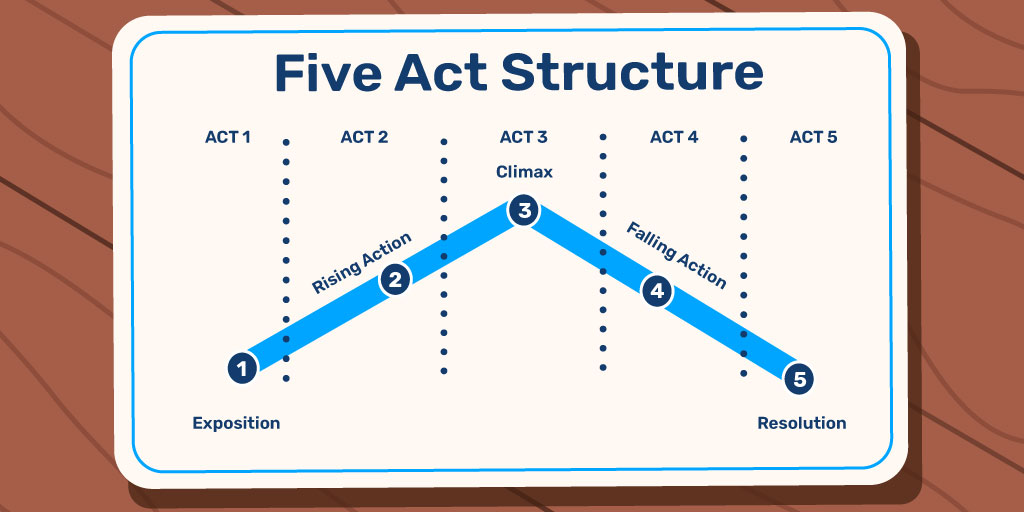
The five-act structure is the same as Freytag’s Pyramid, except that it isn’t historically associated with tragedy. It is also similar to the three-act structure, except that it spends more time on rising and falling action.
These are the five steps:
- Exposition: The story starts with the story’s background, setting, and main characters, and it introduces the main conflict.
- Rising action: A sequence of incidents occur that gradually increase tension and generate conflict, ultimately leading to the story’s climactic moment.
- Climax: The point of greatest tension or conflict in the story.
- Falling action: The consequences of the climax.
- Resolution: The conflict is resolved, with either a happy or unhappy ending.
It is a flexible model that can be applied to many different genres, including tragedy, drama, and historical fiction. Fans of thrillers, adventure, and action genres would probably prefer to have less rising and falling action, but it can work there too.
Example of the Five-Act Structure
The Great Gatsby by F. Scott Fitzgerald is a good example of the five-act structure.
Nick Carraway moves to New York and rents a house on Long Island. He meets his millionaire neighbor, Jay Gatsby, and starts a relationship with Jordan (1). Nick becomes involved in the world of the wealthy elite. Gatsby is obsessed with winning back his former lover, Daisy, who is now married to Tom. They begin an affair and Tom finds out (2).
Gatsby and Tom confront each other, resulting in a series of events that lead to Daisy killing Tom’s mistress, Myrtle, in a car crash (3). Gatsby takes the blame for the accident and Myrtle’s husband shoots dead Gatsby as well as himself (4).
After ending his relationship with Jordan, Nick moves back to the Midwest in order to escape from the emptiness and moral decay of the wealthy on the East Coast (5).
7. Fichtean Curve
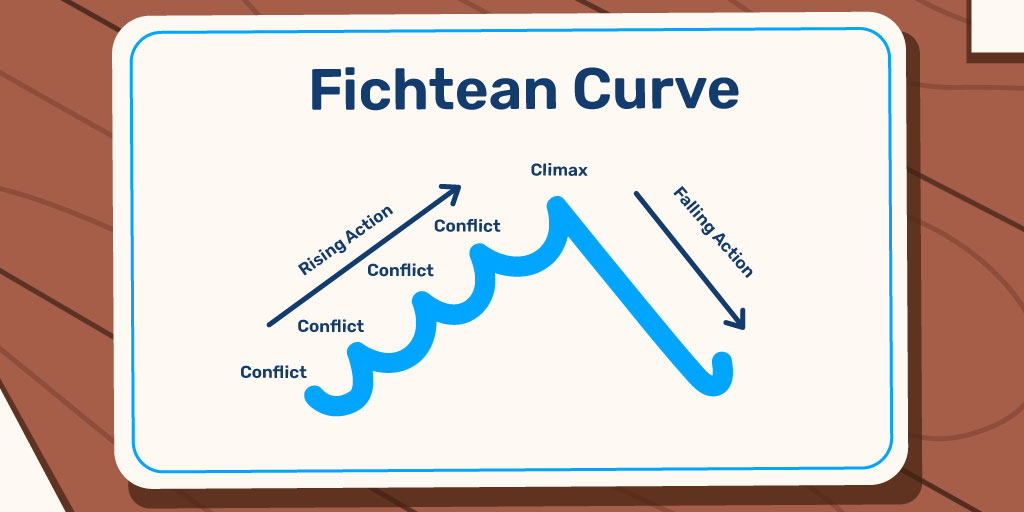
Incorporating various conflicts, the Fichtean Curve drives the plot forward from the very start, without any introduction/exposition. The conflicts exist as part of the rising action, and each one of them has its own buildup and resolution. Eventually, they lead to the story’s climax.
Hence, the story moves forward through the following steps:
- Rising Action: This section consists of various conflicts that climb towards the climax.
- Climax: It occurs at around 70% to 90% through the story and is the most intense part.
- Falling action: Things start to calm down, loose ends are tied up, and the conflict is resolved.
This works in any genre, but especially thrillers, action, mystery, and romance.
Example of the Fichtean Curve
The Wonderful Wizard of Oz by L. Frank Baum dives straight into the action with a tornado that lifts Dorothy’s house into the air, from where she wakes up in the Land of Oz.
All the steps on her quest to get back home are mini conflicts that form part of the rising action, such as her rescuing of the Scarecrow and Tin Woodman, the joining of the Lion, the attack of the part bear-part tiger Kalidahs, her arrival at the Emerald City, the attacks organized by the Wicked Witch of the West, and so on (1).
The climax occurs when she kills the Wicked Witch of the West in a confrontation (2). Her return to the Emerald City, discovery that the Great Oz was a fraud, the scenes at Glinda’s castle, and her return to Kansas are all part of the falling action (3).
8. Save the Cat Beat Sheet

The Save the Cat Beat Sheet was created by screenwriter and author Blake Snyder. It is a tool for storytellers that breaks down a story into 15 key “beats” or plot points, with each beat serving a specific function in the story.
The Save the Cat Beat Sheet is another three-act structure, but each of the three acts is divided into many more steps to provide detailed guidance to authors.
Here are the 15 steps:
- Opening Image: This is the first image or scene in the story, which sets the tone and establishes the setting and main character.
- Set-Up: This introduces the protagonist’s world and establishes their goals, motivations, and flaws.
- Theme Stated: A character states or implies the story’s theme or message, often in the form of a question.
- Catalyst: An event occurs that disrupts the protagonist’s world and sets the story in motion.
- Debate: The protagonist must debate whether to take action or not.
- Break into Two: This is the beginning of the second act. The protagonist makes a decision and takes action towards a goal, entering a new situation.
- B Story: The character encounters a secondary character or subplot that provides an emotional or thematic counterpoint to the main story.
- Fun and Games: The protagonist enjoys initial success and has fun in their new situation, often with comedic or lighthearted moments.
- Midpoint: A major turning point in the story, where the protagonist faces a setback or challenge that forces them to change their approach.
- Bad Guys Close In: The obstacles and challenges increase, with the antagonist or other forces closing in.
- All Is Lost: The protagonist suffers a major setback or failure, often leading to a crisis of confidence.
- Dark Night of the Soul: Things seem hopeless. The character must confront their inner demons and make a difficult decision.
- Break into Three: this is the beginning of act three. The protagonist renews their commitment to the goal and takes a new approach.
- Finale: The protagonist faces the antagonist or overcomes the main obstacle through skills or knowledge they have acquired, often with a final confrontation or showdown.
- Final Image: This is the last image or scene in the story, which reflects on the protagonist’s journey and the story’s themes.
It is a versatile structure that can be applied to absolutely any genre. A protagonist who is looking for love and faces obstacles in their pursuit of a relationship (romance), a hero on a quest who faces challenges along the way (science fiction and adventure), or a character who is struggling to overcome a personal conflict (drama).
Example of the Save the Cat Beat Sheet
Star Wars: A New Hope starts with the starry sky and introduces Luke Skywalker as the protagonist (1). Luke wants to leave his home planet and become a pilot (2).
Obi-Wan Kenobi mentions “the Force” (3). Luke discovers a holographic message from Princess Leia (4). He cannot decide whether to help her or not (5). He leaves his planet to join the rebellion (6). Han Solo and Princess Leia have a relationship (7). Luke settles in (8). Obi-Wan is killed (9).
The Death Star approaches (10) and destroys Alderaan (11). Luke receives otherworldly training from Obi-Wan (12), and decides to use the Force to destroy the Death Star (13). There is a final confrontation between Luke and the Death Star (14), and then we see the heroes receiving medals for their bravery 15).
9. A Disturbance and Two Doorways
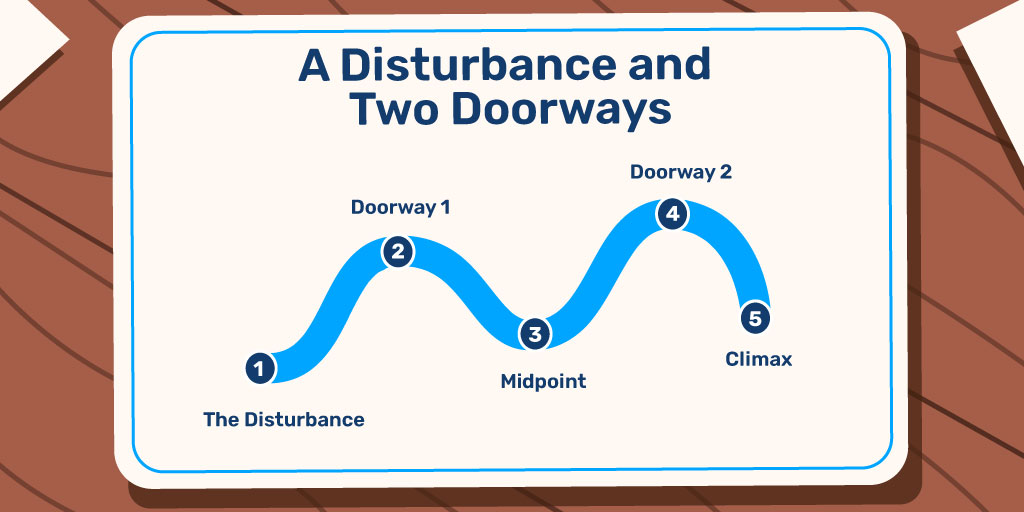
A Disturbance and Two Doorways is the invention of author James Scott Bell. It is a variation of the three-act structure, and is often weaved into other frameworks. The emphasis is on conflict, since nothing happens without conflict.
There are three conflict points:
- The disturbance: This is an event that disrupts the protagonist’s normal world and forces them to take action.
- Doorway 1: The protagonist must make a choice or take action in response to the disturbance, which leads them into a new world or situation. Going back is no longer an option.
- Doorway 2: The protagonist faces another choice or challenge, which leads to the climax of the story.
It is often combined with some kind of five-point structure that includes a midpoint between the two doors and a climax at the end.
- The disturbance: (〃)
- Doorway 1: (〃)
- Midpoint: This is a turning point in the story where the protagonist starts responding more proactively, instead of reactively, to the challenges.
- Doorway 2: This challenge usually arises as a result of the midpoint shift.
- Climax: The protagonist acts on the challenge in doorway 2.
This structure can work with any genre, but is particularly good in the adventure, science fiction, and thriller genres where the protagonist goes on some type of quest. It also works in emotional journeys (drama) and the search for love (romance).
Example of A Disturbance and Two Doorways
In The Matrix, Neo is a programmer/hacker living a normal life. The disturbance occurs when Morpheus tells him that his reality is a simulation (1). In response to this conversation, he chooses to take the red pill to reveal the truth about the Matrix (2). He enters the Matrix to visit the Oracle. Morpheus is captured because of Cypher’s betrayal (3).
Neo decides to rescue Morpheus from the agents, which he does successfully (4). After being killed, he is revived with new abilities to control and perceive the Matrix, and easily defeats Agent Smith and the remaining agents (5).
10. Seven-Point Structure
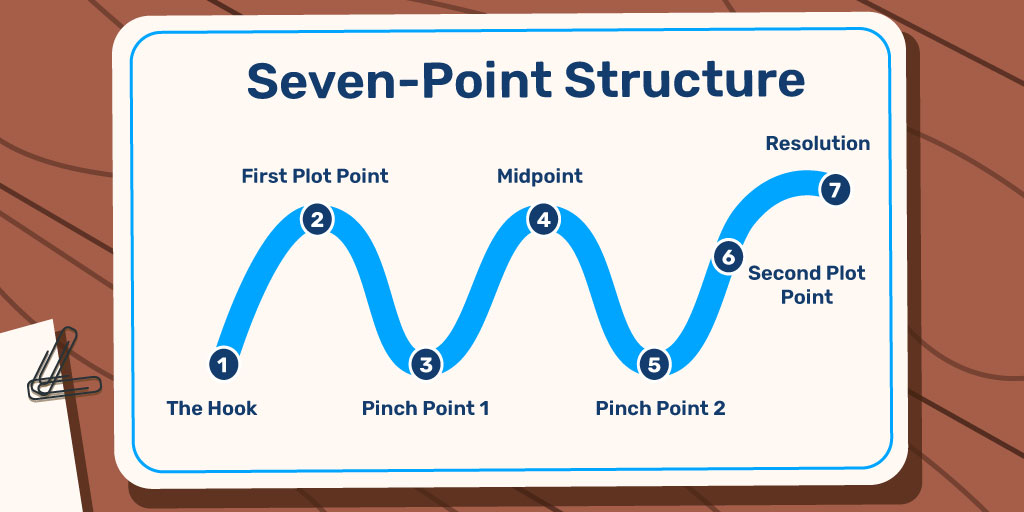
The Seven-Point Structure was developed by sci-fi writer Dan Wells. It consists of seven sequential plot points that he thought were required for building a compelling story. Each serves as a milestone to propel the story forward.
Here are the seven points:
- The Hook: It’s the opening of the story that immediately captures the reader’s attention by introducing the protagonist and their world, along with a hint of the impending conflict.
- First Plot Point: A significant event that happens about a quarter into the story, altering the protagonist’s path and setting up the main conflict.
- Pinch Point 1: A moment just before the midway point of the story where the antagonist or primary obstacle is introduced, reminding the reader of the story’s conflict.
- Midpoint: The story’s midpoint where the protagonist goes through a significant shift in their journey. It can be a moment of success or failure, but it sets up the second half of the story.
- Pinch Point 2: Another reminder of the conflict, usually more intense than the first pinch point.
- Second Plot Point: A significant event occurs three-quarters into the story, paving the way for the final conflict and propelling the protagonist towards the climax.
- Resolution: The climax and conclusion of the story, where the protagonist confronts their most significant challenge and either attains their goal or fails to do so.
Example of the Seven-Point Structure
This structure is also adaptable to any genre, from thrillers to romance fiction, but let’s use Watchers by Dean Koontz to illustrate.
A dog saves Travis Cornell from something that chases them in the woods. He finds out that the dog, whom he names Einstein, has above-average intelligence (1).
They save Nora from a stalker. Nora is creative and finds ways to communicate with Einstein, who tells them that he escaped from the lab where another intelligent killer creature was engineered. The creature, the NSA, and a contract killer called Vince Nasco all want to capture Einstein (2). They encounter the creature at Travis’s house but cannot kill it (3).
Travis and Nora change their names to prevent the NSA from finding them and settle in Carmel to prepare for the creature to find them (4). The creature continues to kill wherever it goes, and both Nasco and the NSA discover their new location (5).
Einstein develops distemper, which dulls his telepathic abilities to sense the creature, and Nasco arrives. Travis kills him (6). In the middle of all that chaos, the creature arrives and the final confrontations occur, first with the creature, and then with the NSA (7).
11. Snowflake Method
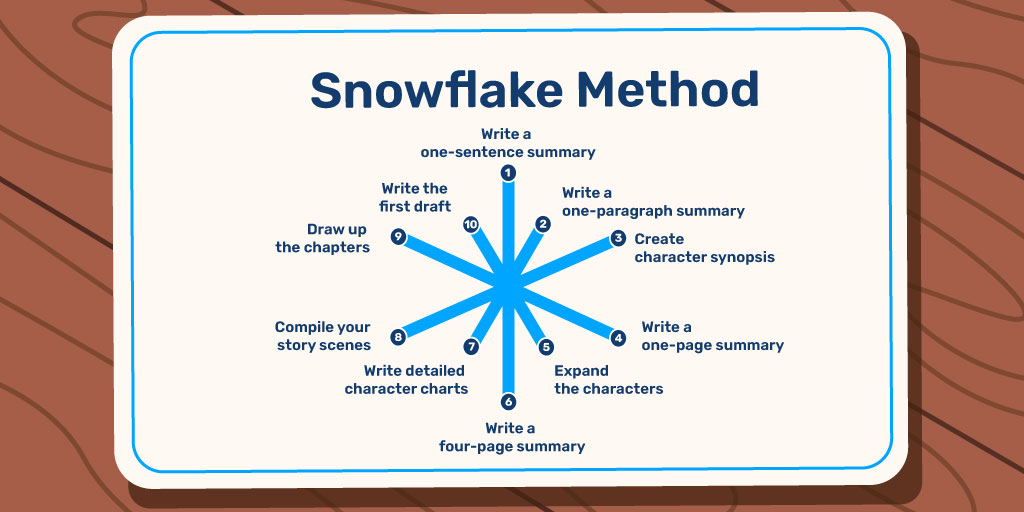
The Snowflake Method was developed by physicist and novelist Randy Ingermanson, and helps authors to plan and outline a plot. It starts from a simple concept and gradually builds up to a fully-developed story.
These are the ten steps:
- Write a one-sentence summary: This should capture the core concept of your novel.
- Write a one-paragraph summary: This should include the setting, conflict, and resolution.
- Create character synopses: Based on your basic plot ideas, start creating simple profiles for some main characters.
- Write a one-page summary: This should include some detail about the characters, plot, and themes.
- Expand the characters: Based on the one-page summary, flesh out the main characters.
- Write a four-page summary: Expand the one-page summary to four pages that include more detail about the major plot points and character arcs.
- Write detailed character charts: Armed with the plot points in the four-page summary, draw up a detailed character chart for each of your main characters, including their backstories.
- Compile your story scenes: Based on the detailed plot points and character charts, outline some of the scenes that will accomplish what you want your plot to do.
- Draw up the chapters: Combine the scenes into a linear structure, divide them into chapters, and write down a one-paragraph summary for each chapter.
- Write the first draft: After creating detailed character profiles, scene outlines, and chapter summaries, you have now equipped yourself with the tools you need to write the complete first draft of your novel.
Since the snowflake method is a guideline for how to compile a novel from a basic idea, it is useful in any genre and for any story concept.
Example of the Snowflake Method
Along Came a Spider by James Patterson, for example, might start with a core concept like this:
When a congressman’s daughter is kidnapped from her private school, Detective Alex Cross and Secret Service agent Jezzie Flanagan team up to track down the kidnapper, but soon realize that they are dealing with a twisted and brilliant criminal mastermind.
12. Kishōtenketsu Structure

Kishōtenketsu is a four-act plot structure common in Asian storytelling. Compared to other frameworks, it lacks a conflict act.
The four parts are as follows:
- Ki (Introduction): The author introduces the characters, setting, and context of the story.
- Shō (Development): The story starts to develop through several events, but without a conflict or tension.
- Ten (Twist): This act provides a twist or unexpected turn in the story, often by introducing a new element or perspective that challenges the assumptions made in the first two parts.
- Ketsu (Conclusion): This is the conclusion of the story that resolves the story, usually by incorporating elements from the first three parts.
This structure works for stories where the conflict is kept to a minimum, and is accordingly better suited to short stories than to full-length novels.
Example of the Kishōtenketsu Structure
Rashōmon, a short story by Ryūnosuke Akutagawa, captures this type of narrative structure well.
The story takes place in Rashōmon, the dilapidated southern gate of Kyoto, where people sometimes dump unclaimed corpses. The plot revolves around the encounter between a lowly servant who has been recently fired and an old woman (1).
The servant is contemplating whether to resort to thievery to survive or to starve. He goes upstairs and finds the old woman stealing hair from the dead bodies. He is disgusted and decides to take the path of righteousness, even if it means he has to starve. The old woman tells him that she steals hair to make wigs to survive (2).
She also reveals that the woman whose hair she is currently stealing cheated people in her life by selling snake meat and claiming it was fish. She justifies her actions, saying it is necessary to survive and her victim was dishonest while alive (3).
The servant responds by robbing the old woman of her robe and disappearing into the night, justifying it by saying that he needs to do it to survive and that his victim is dishonest (4).
13. Red Herring Structure
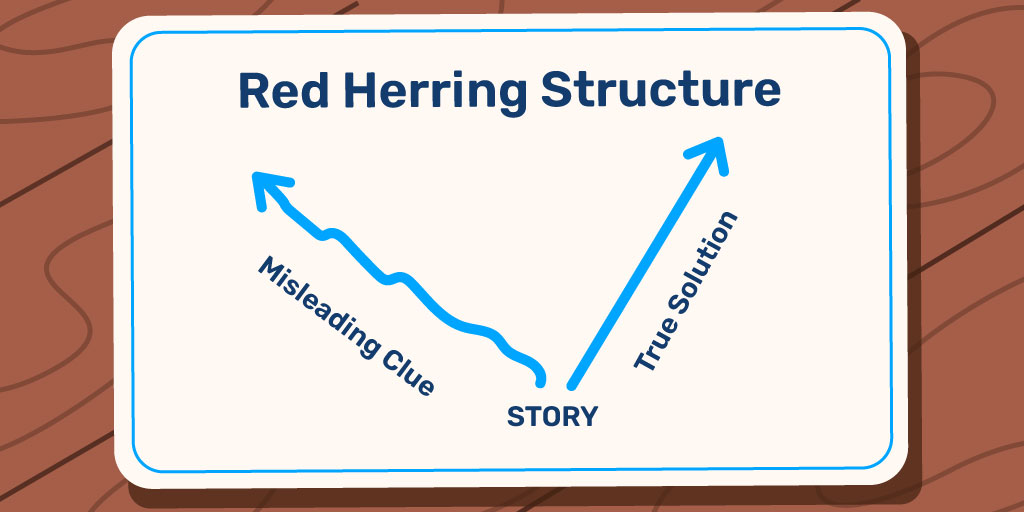
In mystery, crime, and thriller stories, authors often use a narrative device called “red herring,” which is a misleading clue or information meant to confuse the reader or protagonist and divert their attention from the true solution or outcome of the story.
The red herring story structure is based on this device, and it intentionally includes false leads or deceptive clues to misguide the reader or protagonist, leading them to wrong assumptions before finally revealing the real solution or outcome of the story.
This type of narrative can create a sense of suspense and anticipation as the reader or protagonist tries to distinguish the truth from the sea of falsehoods.
It can be combined with any of the story structures in this guide.
Example of the Red Herring Structure
In The Maltese Falcon by Dashiell Hammett, for example, private detective Sam Spade has to work out who killed his partner and Floyd Thursby, the person they were meant to investigate and follow. The story is replete with red herrings.
The police suspect Spade himself. It may have been Dixie Monahan, a Chicago gambler who had employed Thursby as a bodyguard. Clues also point to Casper Gutman, Joel Cairo, and Wilmer Cook. However, the guilty party ends up being Brigid O’Shaughnessy, the woman who hired Spade and his partner.
14. Story Spine
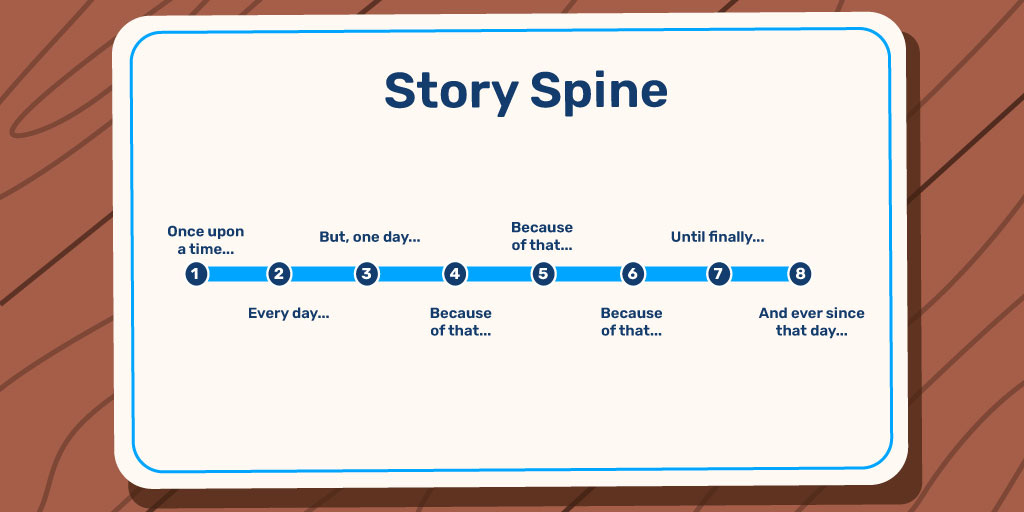
The story spine is a simple framework consisting of an eight-sentence framework. It can be used to create a basic plot for any type of narrative.
It proceeds through sentence prompts that the author should complete.
The eight sentences to flesh out the plot are as follows:
- Once upon a time…: This is the beginning of the status quo.
- Every day…: Here, more of a status quo is established.
- But, one day…: At this point, the inciting incident is introduced; the event that shakes up things.
- Because of that…: This is the beginning of the rising action, with challenges for the protagonist.
- Because of that…: The protagonist’s journey continues in the rising action.
- Because of that: This approaches the climax of the rising action.
- Until finally…: This is the climax, or the most intense part of the story, the point where the protagonist faces their hardest obstacles.
- And ever since that day…: This is the resolution that ties up all remaining loose ends.
Example of the Story Spine
Let’s apply it to Cinderella.
Once upon a time, there was a young girl named Cinderella who lived with her cruel stepmother and stepsisters (1).
Every day, she was forced to do all the household chores while her stepsisters lived a life of luxury (2).
One day, the royal palace announced a grand ball where the prince would choose his bride, which her stepmother forbade her from attending (3).
Because of that, her fairy godmother helped her to attend the ball (4).
Because of that, the prince was immediately smitten with her (5).
Because of that, at midnight, Cinderella fled from the ball, leaving behind only her glass slipper (6).
Until finally, the prince searched the entire kingdom for the owner of the glass slipper and found Cinderella (7).
And ever since that day, they lived happily ever after (8).
15. In Medias Res

In Medias Res is a narrative technique that means “in the middle of things” in Latin. It refers to a story that begins in the midst of the action, skipping over the status quo. Instead of starting at the beginning of the story, In Medias Res starts in the middle or towards the end, and fills in the background later.
It is a narrative technique, rather than a specific story structure, so it doesn’t necessarily proceed through any specific steps. However, it’s important to establish context and background information throughout the story to help the audience understand what’s going on. This can be done through flashbacks, dialogue, or other devices.
It is best to build the background information into the rising action as follows:
- Action: It starts in the middle of an exciting or notable event.
- Explanation-laden rising action: together with an increase in the conflict and the characters’ adjustments to it, the author must use flashbacks, dialogue, and other methods to fill in the background to the story.
- Climax: The point of highest tension, with the protagonist facing their most difficult challenge.
- Falling action: The stage where the conflict begins to wind down and the characters deal with the consequences of the climax.
- Resolution: The part of the story where all remaining loose ends are tied up.
Example of In Medias Res
One example is Killing Floor by Lee Child, which starts with Jack Reacher being unexpectedly arrested for a murder just after arriving in a town called Margrave. He is soon moved to a state prison where he is attacked. Throughout the action-packed narrative, Lee Child fills in his backstory without interrupting the suspense.
Final Thoughts
The power of structure cannot be underestimated in the world of storytelling. Each structure provides a framework for writers to craft compelling and engaging stories. By understanding these structures and how they can be used to build tension, develop characters, and create satisfying resolutions, writers can elevate their storytelling to new heights.
Best of all, since these structures can be learned, people who are not instinctive, born writers can find their way into a career from which they have always felt excluded.
Craft of Writing Quiz (Hard)
